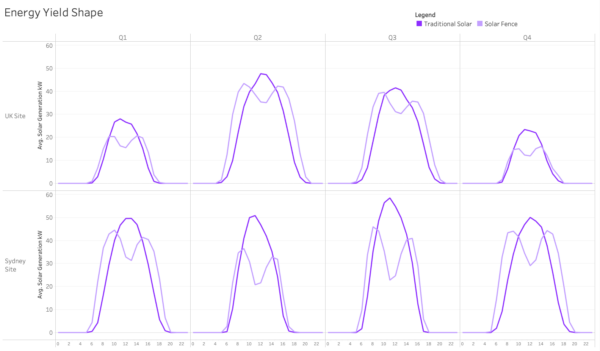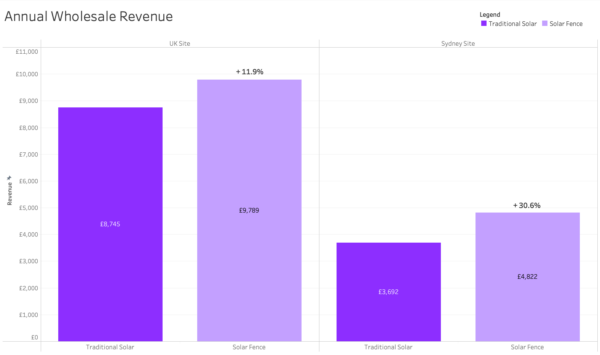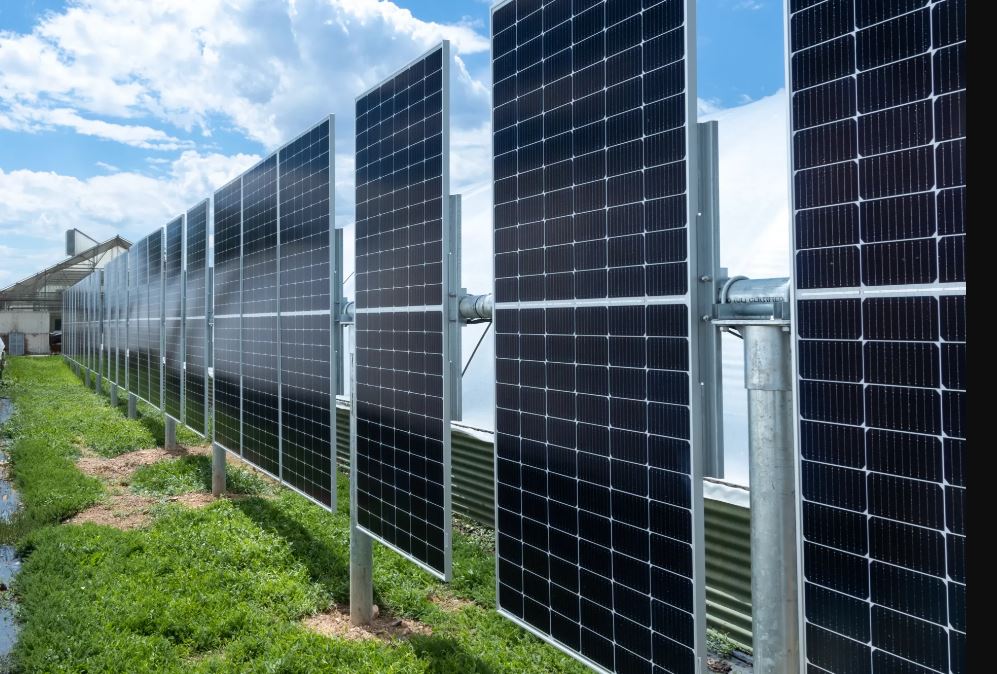Australian energy tech provider Gridcog has revealed that solar fences – effectively a bifacial panel oriented east and west at a 90 degree tilt angle – demonstrate promising yield and revenue potential after conducting a simulation comparing a vertical install to a typical ground-mount solar system.
Gridcog, which provides software to plan, track and optimise distributed energy projects, created two scenarios in the simulation, one using conventional solar and one using a solar fence configuration. It then modelled sites in London and Sydney against both scenarios and ran a one-year model against typical irradiance data for each location.
The conventional solar utilised 100 kWdc / 100 kWac systems for both sites using mono-facial panels. London was oriented 180° south and Sydney 0° north, both with a tilt of 40°.
The solar fence scenario comprised 100 kWdc / 100kWac of bifacial panels. The systems were oriented 90° east/180° west at a tilt of 90°, so perpendicular to the ground.

Unsurprisingly the yield curve for the solar fence was different to ground-mount solar, with a dip in the middle of the day, but on an annual basis, overall yields were slightly higher for the solar fence than for the conventional system.
“We’re seeing a 10% total uplift in yield in London and a 3% increase in Sydney,” Gridcog said, noting that while the physical performance more or less aligned with what was expected, the commercial story provided some interesting results.
The generation pattern of the solar fence allowed it to avoid those lower value periods of the day when lower demand and higher solar generation impact wholesale prices.
Gridcog said this was particularly the case for Sydney where middle-of-the-day prices are on average much lower than prices earlier and later in the day.

Image: Gridcog
“When these wholesale prices interact with our solar yield curves the solar fence really starts to stand out,” the company said, adding that the vertical install is consistently able to capture much higher prices in the market on each side of the middle-of-the-day lows.
“On an annual basis the advantage of the solar fence is even more obvious,” Gridcog said. “The increase in revenue is significantly higher than the underlying increase in yield; in the case of Sydney a 3% increase in yield has translated into a 30% increase in revenue.”
While capex and opex costs were ignored for the simulation exercise, Gridcog finished by saying that solar fences, which use about 10% of the land compared to conventional ground-mount solar, are “a pretty neat concept.”
This content is protected by copyright and may not be reused. If you want to cooperate with us and would like to reuse some of our content, please contact: editors@pv-magazine.com.









Are you saying the fence mounted panels gave the same or near same outcome of kilo watts as the normal roof mounted can you give me some readings of both on the same day as I’m interested in doing some fence panels albeit on the side of my building where there is no shadows
Interesting design concept.
Curious if there have been comparisons done on how the vertical mount designs deal with wind compared with horizontal ground mount designs. In many parts of Australia the wind is significant for a large part of the year. Solar panels aren’t generally designed to deal with direct wind force.
Also, they don’t like rain on back of panels, even with dual glass module, as the moisture sits in bottom of rail when vertical.
.
Intetsting points Rob, also dependant on positioning wind would definitely be of concern….and easy target for vandals maybe??
A panel should be easily able to take the side on wind load.
But can the supports?
In principle it is no different from any other wind blocking fence, and yes, they sometimes get blown over.
Angled struts would help a lot, but get in the way of land use.
Interesting to know what the sunlight effect is on crops or other around the panel.
In theory, something by the panel should get full sun in either the morning, or the afternoon.
That should be better than fixed south facing panels which will out some areas in permanent shade.
If the bifacial modules in the fences were not glass on glass, there could be degradation on the plactic back sheets !